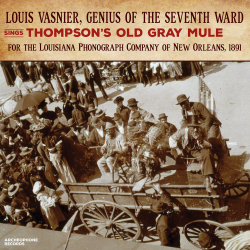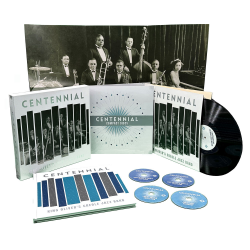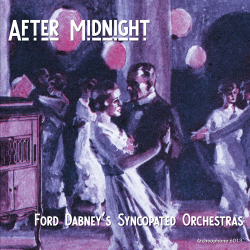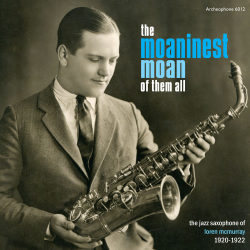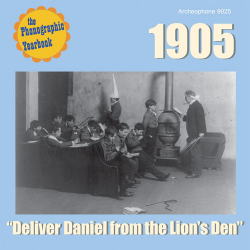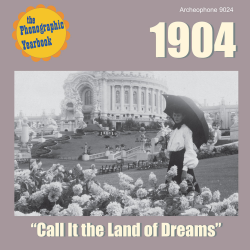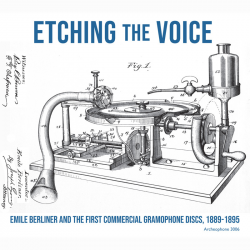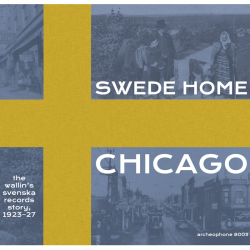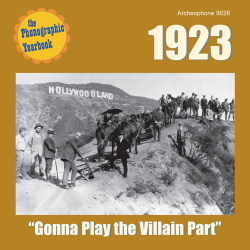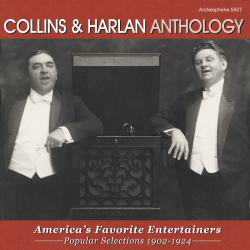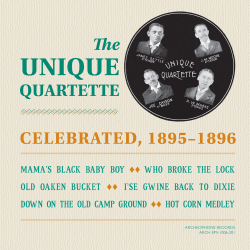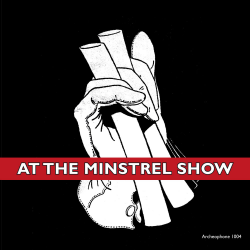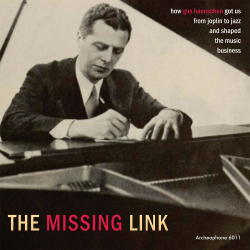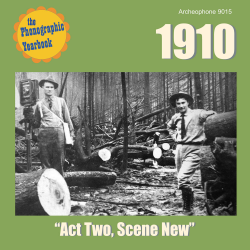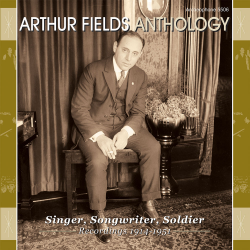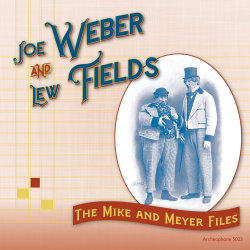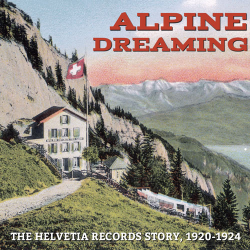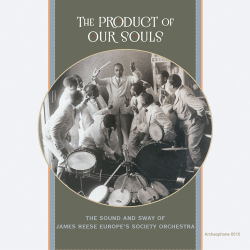Releases There are 91 products.
Genius of the Seventh Ward (Louis Vasnier)
Thirty years before some fiddlers from Texas, Oklahoma, and Georgia started recording a new genre of music called “hillbilly,” a Creole of color from the Seventh Ward of New Orleans named Louis Vasnier (1858–1902) beat them to the punch. Recorded in 1891, “Thompson’s Old Gray Mule” is the most raucous version of a song that, better known as “Johnson’s Old...
$17.99In StockCentennial (King Oliver's Creole Jazz Band)
Centennial will be released on August 30, 2024; order before August 1 for the steepest discount. The 1923 recordings by King Oliver’s working Chicago band are the stuff of legend. Nothing like them had ever been heard on record before, and nothing in jazz would be the same afterward. Here, for the first time, all 37 sides are presented—in release order—on...
$114.95In StockAfter Midnight (Ford Dabney's Syncopated Orchestras)
As a founding member of the all-Black Clef Club, Washington DC-born-and-raised Ford T. Dabney helped revolutionize 1910s society dance music with his chief collaborator, James Reese Europe. In 1916, his syncopated orchestra began a multi-year residency with Flo Ziegfeld’s Midnight Frolic, an after-hours show staged in New York’s New Amsterdam Theatre...
$28.99In StockThe Moaninest Moan of Them All: The Jazz Saxophone of Loren McMurray (Various Artists)
2023 Grammy Nominee, Best Historical AlbumLike Icarus flying dangerously close to the sun, Loren McMurray was an all-too-bright flame in the nascent field of jazz recordings. Dead at only 25, and having made records for just two years, “Mac” was a genuine musical pioneer. His trailblazing sides offered many listeners their first real taste of jazz...
$32.99In Stock1905: "Deliver Daniel From the Lion's Den"
1905: “Deliver Daniel From the Lion’s Den” features 27 popular recordings from 1905, the year Einstein seemingly emerged from nowhere to publish four works that made his reputation and permanently changed our understanding of light, mass, and energy. Highlights include Arthur Collins’ “Preacher and the Bear,” Bob Roberts’ “Back Back to Baltimore,” and two...
$17.49In Stock1904: "Call It the Land of Dreams" (Various Artists)
1904: “Call It the Land of Dreams” presents 27 popular recordings from the year the St. Louis Exposition introduced the world to ice cream cones and America took lead on the Panama Canal. Highlights include “Meet Me in St. Louis, Louis,” “Under the Anheuser Bush,” and “Toyland.”
$17.49In StockEtching the Voice: Emile Berliner and the First Commercial Gramophone Discs, 1889-1895 (Various Artists)
2021 Grammy Nominee: Best Historical Album & Best Album Notes These recordings were made between 1889 and 1895 at the launch of Emile Berliner's disc gramophone in Europe. They are the first and scarcest manufactured sound recordings in the world--the archetypes of the 78, the 45, the EP, and the LP. Gathered together, all surviving discs could be...
$32.99In StockSwede Home Chicago: The Wallin’s Svenska Records Story, 1923-1927 (Various Artists)
Chicago, the most populous Swedish city after Stockholm, was also home to the first record label founded by a Nordic immigrant to the United States. Gustaf Waldemar Wallin, a former crofter from Sweden’s rocky western coast, owned a music shop and launched Wallin’s Svenska Records, issuing 28 ten-inch shellac discs (56 tracks) from 1923 to 1927....
$28.99In Stock1923: "Gonna Play the Villain Part"
The newest volume in our Phonographic Yearbook series. 1923: “Gonna Play the Villain Part” features 25 selections from the year a popular president died amid growing public scandals, a new sign illuminated the Los Angeles skyline, and the country was swept up musically by the question of where one could find bananas.
$17.49In StockAnthology: America's Favorite Entertainers (Arthur Collins & Byron Harlan)
Before Phil and Don Everly, before Simon and Garfunkel, long before Hall and Oates . . . the most popular recording duo over the first quarter of the 20th century was the team of Arthur Collins and Byron G. Harlan. Dubbed “America’s Favorite Entertainers” as they crisscrossed America in the late 1910s and early 1920s promoting Edison’s superior talking...
$16.99In StockCelebrated, 1895-1896 (The Unique Quartette)
They came from the South to make their way in New York City. They worked as hotel porters and singing waiters. And the Unique Quartette, the first African American quartet ever to make records—beginning in 1890—have been a flickering historical mystery until now. Two of their wax cylinders appeared on our GRAMMY-winning Lost Sounds: Blacks and the Birth...
$19.99In StockAt the Minstrel Show (Various Artists)
For all the vexed issues they pose to us now, minstrel shows were an important part of American social life in the 19th and early 20th centuries. In the early days of the phonograph industry, the record labels attempted to bring the experience of minstrelsy into consumers’ homes. The records were popular; hundreds of titles and thousands of examples...
$28.99In StockThe Missing Link (Various Artists)
Under the pseudonym “Carl Fenton,” Gus Haenschen led some of the tightest orchestra recordings of the 1920s—but he also oversaw the musical direction at the Brunswick label, where he signed Isham Jones, Al Jolson, Nick Lucas, Abe Lyman, the Happiness Boys, and even Charlie Chaplin. Haenschen probably would not have gotten that job had it not been for his...
$16.99In Stock1910: "Act Two, Scene New"
1910: “Act Two, Scene New” features 26 selections from the year wildfires in the west shaped environmental policy.
$17.49In StockAnthology: Singer, Songwriter, Soldier (Arthur Fields)
Wanting to run away from home since age eleven, Abraham Finkelstein was always after something. He masked his Jewish background by adopting the stage name Arthur Fields and launched a long and prolific career as a songwriter, vaudevillian, recording artist, radio personality, and music publisher. Featuring 26 tracks and a 32-page booklet with notes by...
$17.99In StockThe Mike and Meyer Files (Joe Weber and Lew Fields)
With their potent mixture of slapstick and fractured German dialect comedy, the pioneering vaudeville duo of Joe Weber and Lew Fields can rightly be called the granddaddy of all American comedy teams. They conquered Broadway with a series of hit burlesque comedies that pointed the way towards “Forbidden Broadway” and Mel Brooks’ “The Producers” and laid...
$16.99In StockAlpine Dreaming: The Helvetia Records Story, 1920-1924 (Various Artists)
In 1920 Ferdinand Ingold, a poor but visionary Swiss settler in the small Wisconsin town of Monroe, audaciously launched a record label, Helvetia—invoking his homeland’s ancient name and celebrating its musical heritage. Praised in the immigrant press yet beset by fiscal challenges, Helvetia issued a scant 36 sides. Scattered, scarce, and nearly...
$27.99In StockThe Product of Our Souls: The Sound and Sway of James Reese Europe’s Society Orchestra
America was hot to trot in 1913, when a craze for social dancing swept across the nation. Vernon and Irene Castle were the faces of that cultural revolu-tion— and the soundtrack was composed by James Reese Europe and played by his bands. An esteemed musician, bandleader, and labor organizer on behalf of his fellow African Americans, Europe described his...
$17.99In Stock
